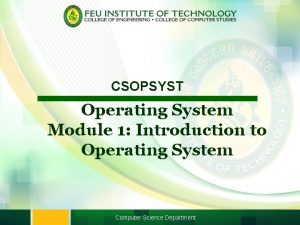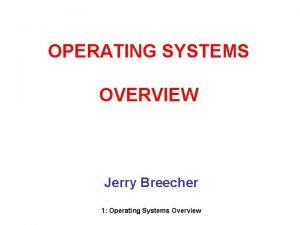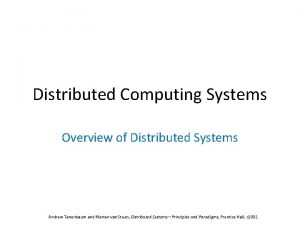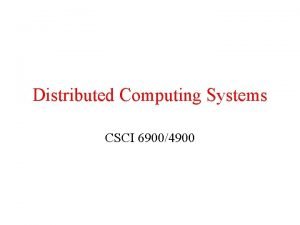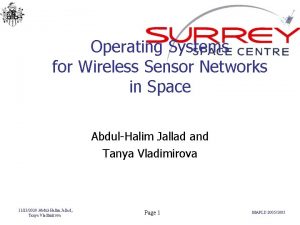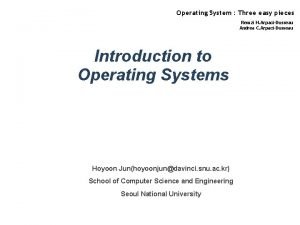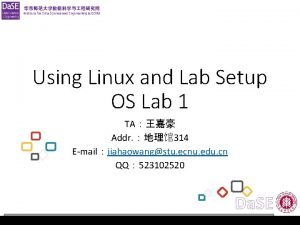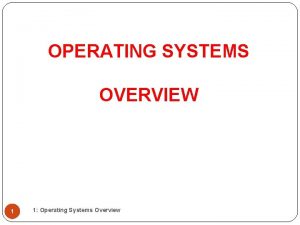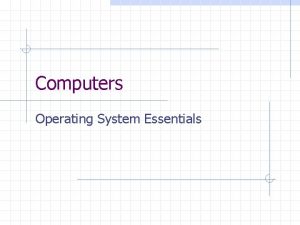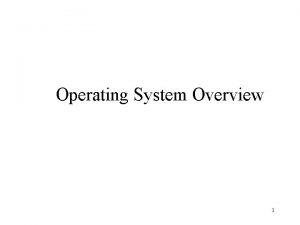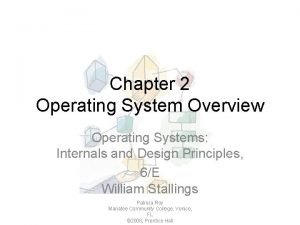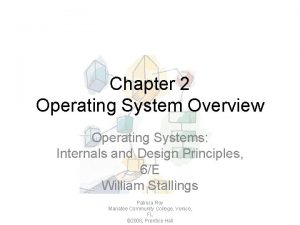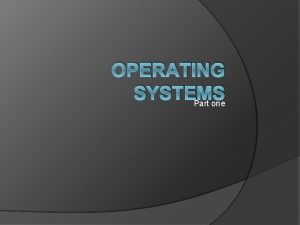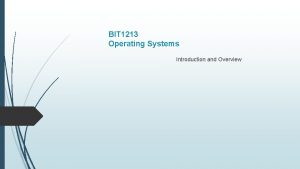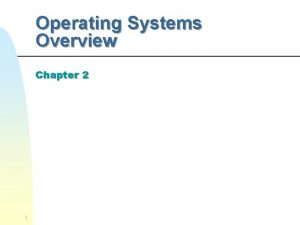Unit OS 1 Overview of Operating Systems 1















- Slides: 15

Unit OS 1: Overview of Operating Systems 1. 2. The Evolution of Operating Systems Windows Operating System Internals - by David A. Solomon and Mark E. Russinovich with Andreas Polze

Copyright Notice © 2000 -2005 David A. Solomon and Mark Russinovich These materials are part of the Windows Operating System Internals Curriculum Development Kit, developed by David A. Solomon and Mark E. Russinovich with Andreas Polze Microsoft has licensed these materials from David Solomon Expert Seminars, Inc. for distribution to academic organizations solely for use in academic environments (and not for commercial use) 2

Roadmap for Section 1. 2. History of Operating Systems Tasks of an Operating System OS as extension of the hardware Main concepts: processes, files, system calls Operating system structuring 3

The Evolution of Operating System Functionality Batch Job Processing Linkage of library routines to programs Management of files, I/O devices, secondary storage Multiprogramming Resource managment and sharing for multiple programs Quasi-simultaneous program execution Single user Multiuser/Timesharing Systems Management of multiple simultaneous users interconnected via terminals Fair resource management: CPU scheduling, spooling, mutual exclusion Real-Time Systems (process control systems) Management of time-critical processes High requirements with respect to reliability and availability 4

Tasks of an Operating System Processor management - Scheduling Fairness Non-blocking behavior Priorities Memory management Virtual versus physical memory, memory hierarchy Protection of competing/conurrent programs Storage management – File system Access to external storage media Device management Hiding of hardware dependencies Management of concurrent accesses Batch processing Definition of an execution order; throughput maximization 5

Kernel- and User Mode Programs Typical functionality implemented in either mode: Kernel: Privileged mode Strict assumptions about reliability/security of code Memory resident CPU-, memory-, Input/Output managment Multiprocessor management, diagnosis, test Parts of file system and of the networking interface User Space: More flexible Simpler maintenance and debugging Compiler, assembler, interpreter, linker/loader File system management, telecommunication, network management Editors, spreadsheets, user applications 6

Layered Model of Operating System Concepts nr name typical objects typical operations 1 Integrated circuits register, gate, bus Nand, Nor, Exor 2 Machine language instruction counter, ALU Add, Move, Load, Store 3 Subroutine linkage procedure block Stack Call, JSR, RTS 4 Interrupts interrupt handlers Bus error, Reset 5 Simple processes process, semaphore wait, ready, execute 6 Local memory data block, I/O channel read, write, open, close 7 Virtual model page, frame read, write, swap 8 Process communication channel (pipe), message read, write, open 9 File management files read, write, open, copy 10 Device management ext. memory, terminals read, write 11 I/O data streams open, close, read, write 12 User processes user processes login, logout, fork 13 Directory management internal tables create, delete, modify 14 Graphical user interface window, menu, icon OS system calls 7

Operating Systems Evolution 55 IOCS IBSYS 60 CTSS 65 DOS/360 70 75 TSO DOS/VDSE MVS/370 VM/370 SYSTEM III 80 85 VS MVS/XA VM/XA SYSTEM V 90 VS/ESA MVS/ES 95 MULTICS CP/CM 5 VM/ESA SYSTEM V. 4 UNIX RSX-11 M UNIXV. 7 VMS 1. 0 4. 1 BSD XENIX MS-DOS 1. 0 SUN OS 4. 2 BSD AIX POSIX MACH OSF/1 4. 3 BSD AIX/370 LINUX AIX/ESA SOLARIS 2 00 03 RT-11 4. 4 BSD CP/M OS/2 WIN 3. 0 VMS 5. 4 DR/DOS WIN 3. 1 WIN NT WIN 9 X VMS 7. 3 WIN 2000 LINUX 2. 6 SOLARIS 10 WIN XP WIN Server 2003 8

Structuring of Operating Systems Monolithical systems App User Mode Unstructured Kernel Mode System services Supervisor call changes from user mode into kernel mode OS procedures Hardware 9

Layered OS Each layer is given access only to lower-level interfaces Application Program User Mode Kernel Mode System Services File System Memory and I/O Device Management Processor Scheduling Hardware 10

Microkernel OS (Client/server OS) Kernel implements: Scheduling Memory Management Interprocess communication (IPC) Client App Memory Server Process Server Network Server File Server Display Server User Mode Kernel Mode request Microkernel reply User-mode servers Hardware 11

VMS and Windows - a bird’s-eye view on architectures Environment Subsystems System & Service Processes Layered design for VAX/VMS operating system User Application Subsystem DLL OS/2 Windows User Mode Layered Products (Apps) Program Development Tools Utilities Executive Device Drivers Command Language Interpreter (CLI) Supervisor Record Management Service (RMS) Executive System services Kernel Memory Management Kernel Mode Support Libraries User I/O Subsystem POSIX Hardware Abstraction Layer (HAL) Kernel Windows User/GDI Device Driver Windows high-level architecture Process and time management System-wide data structures Platform-Adaptation Layer (PAL) - Alpha 12

Release History Although product name has varied, internally, each version identified by a “build number” Internal identification - increments each time NT is built from source (5 -6 times a week) Interesting timeline: http: //windows 2000. about. com/library/weekly/aa 010218 a. htm Build# 297 511 807 1057 1381 2195 2600 3790 4051 Version PDC developer release NT 3. 1 NT 3. 51 NT 4. 0 Windows 2000 (NT 5. 0) Windows XP (NT 5. 1) Windows Server 2003 (NT 5. 2) Longhorn PDC Developer Preview Date Jul 1992 Jul 1993 Sep 1994 May 1995 Jul 1996 Dec 1999 Aug 2001 Mar 2003 Oct 2003 Within the CRK, the term Windows refers to Windows 2000, XP, Server 2003 13

Windows And Linux Evolution Windows and Linux kernels are based on foundations developed in the mid-1970 s 1990 4. NT W W in do w s VM S NT v 1 3. 1 2000 1980 1990 2000 v 2. 2 v 2. 3. 4 v 2. 6 . 0 v 2 v 1 x nu Li V 6 IX UN UN IX bo r n pu bl ic 1970 0 in do W ws in 2 d 0 Se ow 00 rv s X er P 20 03 1980. 0 1970 (see http: //www. levenez. com for diagrams showing history of Windows & Unix) 14

Further Reading Dennis M. Ritchie, The Evolution of the Unix Time-sharing System, in Proc. of Lang. Design and Programming Meth. Conf. , Sydney, Australia, Sept 1979, Lecture Notes in Computer Science #79, Springer-Verlag, 1980. David Donald Miller, Open. VMS Operating System Concepts, 2 nd Ed. , Digital Press, 1997. History of Digital Operating Systems (from pp. 447) Mark E. Russinovich and David A. Solomon, Microsoft Windows Internals, 4 th Edition, Microsoft Press, 2004. Historical Perspective (from pp. xix) G. Pascal Zachary, Show Stopper! The Breakneck Race to Create Windows NT and the Next Generation at Microsoft, ISBN: 0029356717, Free Press, 1994. 15
 Dual mode in os
Dual mode in os Operating system overview
Operating system overview Distributed systems overview
Distributed systems overview Sap easy cost planning
Sap easy cost planning Introduction to distributed computing
Introduction to distributed computing Email writing informal
Email writing informal Unit 10, unit 10 review tests, unit 10 general test
Unit 10, unit 10 review tests, unit 10 general test Operating system examples
Operating system examples Evolution of operating systems
Evolution of operating systems Components of an operating system
Components of an operating system Components of operating systems
Components of operating systems Wsn operating systems
Wsn operating systems Operating systems 3 easy pieces
Operating systems 3 easy pieces Operating system lab
Operating system lab Introduction to operating systems
Introduction to operating systems Modern operating system
Modern operating system
